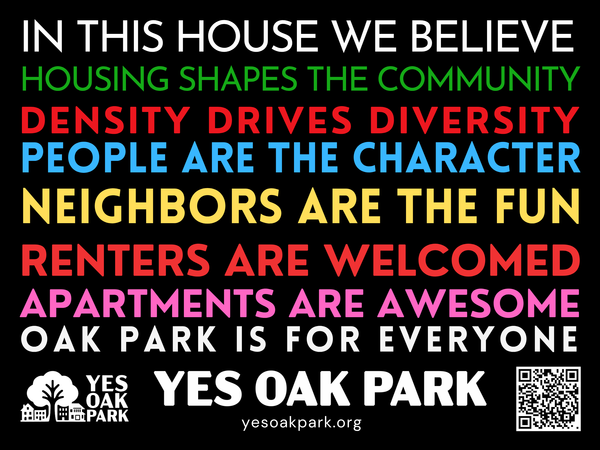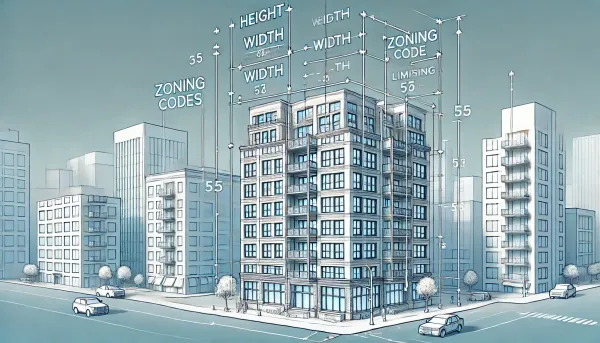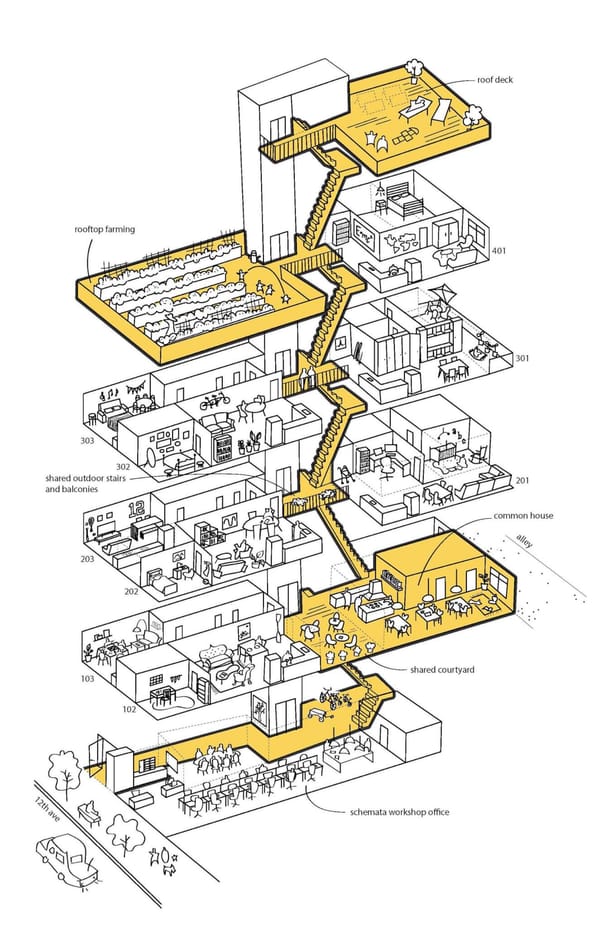Oak Park Housing Myths
Work on local housing politics long enough and you'll start to see the same arguments over and over again. Here's a decoder ring.
You could fill a book with the arguments housing opponents use across the nation to oppose new construction. But like just like our architecture, here in Oak Park, our anti-housing arguments are special.
Myth 1: "Oak Park Is Already Too Dense"
We're actually at a 75-year low.
The current population of Oak Park is around 52,900. That's down, 700 people, from our 1990 population, even including residents of the newer downtown high-rises like the Albion.
But for the real story, look further back: in 1951, according to contemporaneous reporting in the Chicago Daily Tribune, we had a population exceeding 70,000.
Oak Park was in the 1950s almost 25% denser than it is now. Things worked fine. Said then-zoning-board president Elmer Erickson, "Few communities have had a more orderly development, sustained by continuous high standards and and active citizen participation in government".
Myth 2: "Denser Housing Aggravates Flooding"
No it doesn't. Density isn't why we flood.
Like all of Chicagoland, Oak Park (especially in the northeast) is prone to basement flooding. Flooding is caused by rain, not home water usage. Chicago runs combined waste and storm water sewer systems. They bottleneck during big storms. Waste water outflows aren't a factor.
Meanwhile, in areas where flooding is of particular concern, new construction could actually relieve pressure on the sewers, by introducing roof and subsurface retention for stormwater.
Basement floods suck a lot. But housing doesn't cause it.
Myth 3: "Housing Crowds Out Retail"
This is exactly backwards. Residential development drives commercial development; "retail follows rooftops".
This comes up when housing is proposed on commercial lots. Recently, on Chicago Ave, a developer proposed a medium-sized apartment building on a lot occupied by a decade-long-abandoned dentist's office. Neighbors protested the development, claiming it would starve the corner of retail space.
That corner today features a Domino's Pizza, a haunted GoLo gas station, two nail spas and two dry cleaners (nail spas and dry cleaners are two of the least lucrative, lowest-margin uses of retail space, and a clear indication of low demand).
Many of Oak Park's commercial corridors are moribund. The Chicago Ave. corridor is commercially disinvested almost to the point of being dangerous. Imagine walking near Chicago and Taylor at night as a car pulls up next to you. Is anyone watching? Of course not: nothing is open, nobody's there.
If retail developers wanted space on these corners, they'd already have bought it. They don't, because there's no foot traffic. If we want more retail, we need to build the customer base.
Myth 4: "Single Family Housing In Oak Park Can Be Affordable"
No it can't: we're all out of space for single-family homes.
A 3-person household at the "moderate income" threshold of 80% of AMI for Oak Park earns $86,350 (current median household income in Oak Park proper is around $108,000). With that income, a family could afford a house in the mid-$300,000 range. As of the time I'm writing this, there is one house in Oak Park (on Austin Blvd, natch) in that price range. The median listing on Redfin is $600,000.
Oak Park is landlocked. Over 70% of our land area, and almost all of our residential lots, are exclusively zoned single-family. All of them are already fully developed. We cannot make housing affordable at our current level of density.
Myth 5: "Rental Housing Overcrowds Our Schools"
Unlike apartment occupants, virtually every single-family buyer plans to send kids to our schools.
D97 (our elementary and middle schools) and D200 (OPRF) make up about 2/3rds of our property tax burden. Most of your taxes pay for our schools. And overwhelmingly, students at these schools live in single-family houses. According to Trustee Cory Wesley, at the time he joined the Village Board, there were fewer than 50 kids living in multifamily housing enrolled at OPRF.
That's what you'd expect. It's not just that families with school-aged children prefer houses with yards to apartments. With our property tax rates, it's irrational to buy a single-family home in Oak Park without expecting to send kids to our schools. Without a thriving market for townhomes, two-flats, and condos, it's difficult for older households to "age in place", so we're gradually squeezing households without school enrollees out of the village.
This is especially problematic because our schools spend much more per pupil than families pay in property taxes. A family that puts two kids K-12 through D97 and D200 will need to pay property taxes for more than a decade after their youngest graduates. Many make the rational decision not to do that, moving out of the Village when their kids leave school.
Myth 6: "The HPC Just Protects Landmarks"
The Historical Preservation Commission administers our three preservation districts:
- the Frank Lloyd Wright District, created during a scare about the end of racial redlining in the early 1970s,
- the Ridgeland District, commemorating "stucco", created during a scare about the 1980 decennial census showing a sharp increase in Black families moving to Oak Park, and
- the relatively small Gunderson district.
Put together, these districts cover about half of Oak Park's residential land.
Within any Oak Park historical district, almost every freestanding building is designated a "contributing structure". This despite only a tiny number of them having any documented historic status.
This means that whether you live in the FLW Peter A. Beachy house or a nonnotable foursquare Queen Anne on Grove, the rules are the same: major changes to your house must first be approved by the HPC.
The HPC publishes a 100+ page guidebook dictating materials and design. It rarely approves major changes. One resident recently had to have the Village Board overrule the HPC when her house was declared by her insurer to be a total loss and the HPC refused to allow rebuilding.
Myth 7: "Developers Abuse The Variance Process"
A "variance" is when the Village board overrules part of the zoning code. "Developers" are anybody who builds housing.
For the last 80 years, Oak Park has deliberately made it difficult to build multifamily housing without variances. Setbacks, height restrictions, lot sizes, and parking requirements are all obstacles past boards erected to prevent "as-of-right" construction of anything but single-family houses. Variances are the system working as designed.
This process began with Harland Bartholomew's zoning plan of 1947, the foundation of our current zoning map. It had an explicit goal of minimizing rental housing in the village (and an unstated goal of keeping Black families out; "Harland Bartholomew" is a name worth Googling). Bartholomew's plan was so complicated an appeals court panel remarked, "A mere glance at the maps involved in the cause here is convincing that there is no relationship between the change effected in 1947 and the public welfare".
Myth 8: "IZO Fees Are A Loophole"
An IZO is an "Inclusionary Zoning Ordinance". The stated purpose of an IZO is to increase affordable housing. In Oak Park, our IZO applies to new multifamily developments near public transit.
Developers satisfy the IZO either by providing a set number of in-building affordable units, or by tithing an in-lieu fee to the Oak Park Housing Trust Fund.
Opponents of housing density don't like the in-lieu fee. They know that it's very hard to get in-building new construction affordable units to pencil out, especially when the Oak Park plan and development process exerts tremendous pressure to minimize the total number of units in a building. Without the in-lieu fee option, a lot of new housing simply couldn't get built: developers would lose money on it.
But the fact is, the in-lieu fee makes more sense than in-building units anyways. It's easy to see why when you stop to think about it: new construction is expensive! It's much more efficient to add new units at market rates and allow developers to fund affordable housing where their dollars stretch further. And that's exactly what has happened: the Housing Trust Fund has done more to support affordability than in-building affordable units could have.



